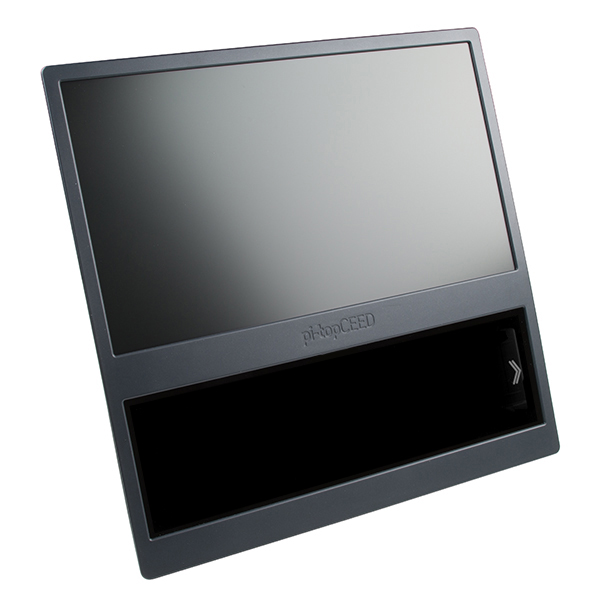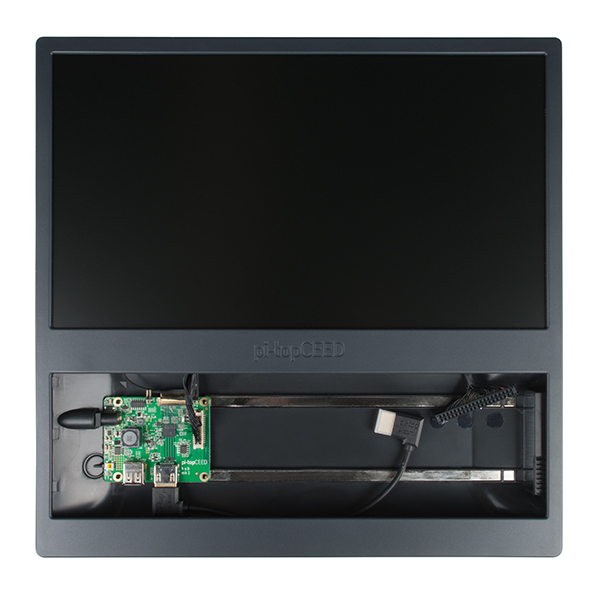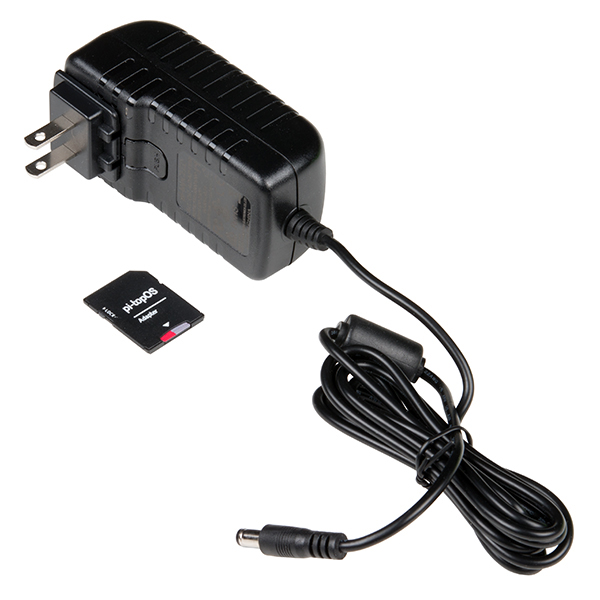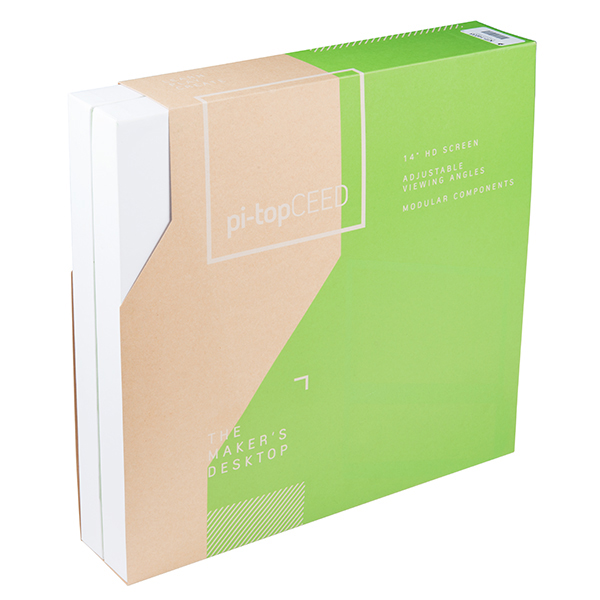pi-topCEED (Gray)
The pi-topCEED is a DIY desktop computer that helps you start learning how to code, create awesome devices and take your knowledge to the next level. This Raspberry Pi-powered computer is an excellent resource to any budding hobbyist, student or intrigued user wanting to learn more about the capabilities of the credit card-sized development board. The only things this kit doesn't include are its own Raspberry Pi, keyboard, mouse and speakers; you'll need to supply those on your own. We purposefully chose the pi-topCEED without its own RPi due to the fact that most of you already own your own board and may not want to use a different or more expensive one.
The gray pi-topCEED comes with a 14" HD LCD screen (1366 x 768 resolution) and a Hub PCB to take care of power management and a host of other functions. Don't worry about cables or your OS either; everything to hook up each part in the box is included, along with the latest version of the pi-topOS on an 8GB microSD card. Designed with ergonomics in mind, the pi-topCEED comes with a back stand that is adjustable up to 180° and can even be wall-mounted. Unlike the pi-top, little to no assembly is required -- just install your Raspberry Pi, plug in power to a wall outlet, and you are good to go!
All pi-topCEEDs come preloaded with CEEDuniverse, a multiplayer online game that teaches you how to code, build circuits and make hardware that interacts with the game in real time. For example, you’ll be mining for resources in CEEDuniverse. However, you must program your mining bot in order to activate your Mining Machine. Speaking of mining, Minecraft comes pre-installed on each computer as well!
Note: Need a Raspberry Pi to use with your pi-top? Never fear; we have you covered with the new Raspberry Pi 3!
- Pi-Top PCB Hubs
- 14" HD LCD Screen
- Gray Injection Molded Case
- Internal Cables
- Power Supply
- Customizable Acrylic Slice for Easy Access
- Pi-topOS SD Card
- Free CEEDuniverse Educational Game
- Free Minecraft Raspberry Pi Game
- Illustrated Instructions
- Consistently Updated Operating System
- Instruction Manual
- pi-top OS Polaris (Make sure to check for new updates!)
- CEEDuniverse
- Product Page
pi-topCEED (Gray) Product Help and Resources
Using pi-top products with the Raspberry Pi 3 B+?
Using the Raspberry Pi 3B+? You need pi-topOS version 2018-04-03 or newer or your Pi will get stuck on the "rainbow screen of death." You can download the newest version of the OS at the link below. https://pi-top.com/products/os#download
Core Skill: DIY
Whether it's for assembling a kit, hacking an enclosure, or creating your own parts; the DIY skill is all about knowing how to use tools and the techniques associated with them.
Skill Level: Noob - Basic assembly is required. You may need to provide your own basic tools like a screwdriver, hammer or scissors. Power tools or custom parts are not required. Instructions will be included and easy to follow. Sewing may be required, but only with included patterns.
See all skill levels
Core Skill: Programming
If a board needs code or communicates somehow, you're going to need to know how to program or interface with it. The programming skill is all about communication and code.
Skill Level: Noob - Programming will be limited to basic drag and drop interfaces like ModKit or Scratch. You won't be writing code, but you will still need to understand some basics of interfacing with hardware. If you?re just using a sensor, it's output is analog.
See all skill levels
Core Skill: Electrical Prototyping
If it requires power, you need to know how much, what all the pins do, and how to hook it up. You may need to reference datasheets, schematics, and know the ins and outs of electronics.
Skill Level: Rookie - You may be required to know a bit more about the component, such as orientation, or how to hook it up, in addition to power requirements. You will need to understand polarized components.
See all skill levels
Comments
Looking for answers to technical questions?
We welcome your comments and suggestions below. However, if you are looking for solutions to technical questions please see our Technical Assistance page.
Customer Reviews
4.4 out of 5
Based on 7 ratings:
1 of 1 found this helpful:
Great value
I like it. Hard to get just a LCD for this price. You can use your favorite OS with it. Not limited to just Pi-Top OS.
1 of 1 found this helpful:
Easy as it can be.
Everything is well considered. This is a snap to assemble and operate. Linux has become an effective, competitive alternative to windows.
Simply put: the Pi-TopCEED will keep both your in-progress projects and completed ones tidy while saving space on your desktop. I would actually dread doing Raspberry Pi projects because of the sprawl it created in my work space.
Also this makes a great screen for exhibits! I plan to use one to showcase student work by having the screen change information while each piece gets sequentially lit by an overhead lamp. Perhaps incorporate a gesture sensor!
Very nice!
I love the monitor screen's size and resolution, fits the Pi nicely, easy to set up. Going to use it for digital ham radio if I can get WSJT-X to run on it.
Nice display unit/test bed for the Pi
A very nice unit, the gray (looks black to me) version fits into my office decor wonderfully.
I cannot imagine why anyone would want the green version, each to their own I guess.
Installing the pi was simple. The rail mounts work well, I just wish they had included multiple sets of the magnetic standoffs to prevent the necessity of removing them to move to different SBCs. I've looked on Pi-Top's web site and they don't appear to sell them. Still looking.
Word of warning: The included software DOES NOT work with the new Pi3 B+
You can find the latest version of the pi-topOS here. The latest version does work on the Pi3 B+. :-)
Pretty Good!
I've tried many different Pi cases, but none have really satisfied me. I simply get tired of the interface cables. This solved my problem. I use this with a Logitech wireless keyborad/mouse combination, and it really works well...so well that I haven't even thought of booting up the Pi-Top operating system yet. Too bad they didn't drill a hole for the audio plug, but eventually I will do that myself. Oh, wait, they want to sell their $20 (each!) HDMI speakers. Overkill for me.
Easy to use LCD for your raspberry pi, software has potential but needs debugged
I was really excited about the software package that came with it. Mostly the aids to programming as well as the CEEDuniverse game. The game is buggy and the software that is supposed to help you learn to program is unavailable after the initial splash screen just sort of disappeared, and I can't find the means of opening the program without the splash screen. Has potential, but needs work. Hardware is excellent, no dead pixels and installation was a breeze.
I would recommend taking a look at Pi-Top website. They have a good community, as well as a "Get in touch" tab on their page. There should be some information that that will prove useful.







Is there enough overhead clearance for HATs under the cover?
Can this be used as a typical LCD screen via the HDMI connector on the driver board? I plan to use this for my raspberry Pi 3, but I also plan to use it as a screen for my DSLR camera for a photobooth build, which would require an HDMI connection directly to my camera.
Would be good to specify up above (ahem) which Pis this works with. I have an original Model B, for instance, and I cannot tell right now if it's compatible.
...I hear crickets...
;)